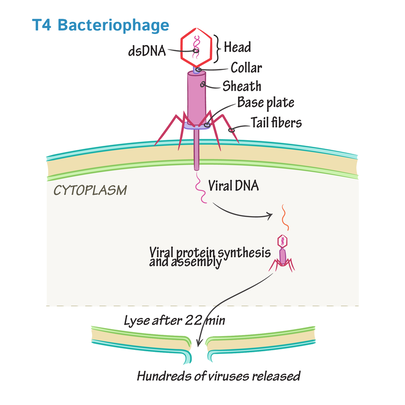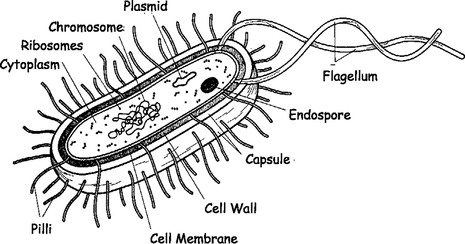Unit 17: Immune System & Disease
Reading
BJU: Ch. 10 - "Bacteria and viruses", and section 22B - "The lymphatic system and immunity"
OpenStax Biology: Ch. 42 The Immune System
Topics
Labs
BJU: Ch. 10 - "Bacteria and viruses", and section 22B - "The lymphatic system and immunity"
OpenStax Biology: Ch. 42 The Immune System
Topics
- Viruses
- Immune system
- Lymphatic system
Labs
- HHMI Virus Explorer weblab
- Bio-Rad Microbes and Health lab (Yogurtness lab)
Lecture outline
Viruses are not considered alive. They have no cell membrane, or internal organelles; and they do not divide. Instead, they invade a host cell, inject their DNA or RNA, and take over the machinery of the host cell to make copies of themselves. Viruses infect all types of organisms - animals, plants, bacteria, etc.
Bacteria are living, single-celled organisms, about 1/1000ths the size of a human cell, but huge compared to viruses! All bacteria are prokaryotes (no nucleus, no organelles, divide by binary fission), but they are divided into two kingdoms - Archaebacteria and Eubacteria.
A breakdown of the immune system:
Type 1: Innate immunity (innate = what you're born with)
A) Physical barriers
Type 2: Adaptive immunity (also known as specific or targeted or acquired immunity)
Your adaptive immune response kicks-in if your innate immune response (above) is insufficient.
The adaptive immune system responds to an antigen; antigens are foreign substances that provoke an immune response.
Antigens are typically organic molecules not normally found in the body
B-cells and T-cells are types of white blood cells called lymphocytes
B-cells produce specific antibodies which circulate throughout the body and bind to antigens to 'tie them up' - so they can't bind to their target, and a macrophage can come along and eat it up.
Helper T-cells release chemicals that help other white blood cells recognize and destroy antigens
Cytotoxic T-cells release toxic chemicals that destroy target cells
Viruses are not considered alive. They have no cell membrane, or internal organelles; and they do not divide. Instead, they invade a host cell, inject their DNA or RNA, and take over the machinery of the host cell to make copies of themselves. Viruses infect all types of organisms - animals, plants, bacteria, etc.
Bacteria are living, single-celled organisms, about 1/1000ths the size of a human cell, but huge compared to viruses! All bacteria are prokaryotes (no nucleus, no organelles, divide by binary fission), but they are divided into two kingdoms - Archaebacteria and Eubacteria.
A breakdown of the immune system:
Type 1: Innate immunity (innate = what you're born with)
A) Physical barriers
- Skin
- Mucous (in nose, throat, etc)
- Cilia (sweeping action)
- Stomach acid
- Tears
- Saliva
- Urine
- Other secretions
- White blood cells (leukocyte = white + cell)
- Neutrophils and macrophages migrate to area of infection and engulf and destroy invaders - known as phagocytosis
- Eosinophils produce toxins
- Natural killer cells police the blood and lymph, cause cell lysis of virus-infected cells
- Inflammatory response - redness, heat, swelling
- Fever - speeds up repair
- Blood vessels dilate, become more permeable, allow soldiers, chemicals, clotting factors to move to the area
Type 2: Adaptive immunity (also known as specific or targeted or acquired immunity)
Your adaptive immune response kicks-in if your innate immune response (above) is insufficient.
The adaptive immune system responds to an antigen; antigens are foreign substances that provoke an immune response.
Antigens are typically organic molecules not normally found in the body
- Toxic molecules attached to the cells of bacteria, fungi, etc.
- Various molecules which present on the surface of virus-infected cells
- Chemicals in poison ivy, animal dander, detergents, cosmetics, etc.
- Foreign molecules on pollen
B-cells and T-cells are types of white blood cells called lymphocytes
B-cells produce specific antibodies which circulate throughout the body and bind to antigens to 'tie them up' - so they can't bind to their target, and a macrophage can come along and eat it up.
- Antibodies are large Y-shaped proteins with two 'crab arms' that bind up antigens and clump them together. Your body has one billion(!) different antibodies, each with a unique shape, and each targeted to a different potential antigen.
- Antibodies are found in blood, lymph fluid, tears, saliva, breast milk, and other body fluids.
Helper T-cells release chemicals that help other white blood cells recognize and destroy antigens
Cytotoxic T-cells release toxic chemicals that destroy target cells
| Immune System lecture slides |
Homework
Immune System questions, posted in Canvas


